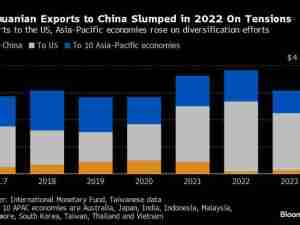Australia’s surging imports in the final three months of 2021 are likely to take some of the shine off the economy’s powerful consumption-fueled rebound through the period.
The nation’s trade surplus narrowed further in December to A$8.4 billion ($6 billion), well below economists’ A$9.9 billion estimate, Australian Bureau of Statistics data showed Thursday. Import values jumped 7.3% for a second consecutive month, while exports advanced by 3.3%.
The result suggests trade was a significant drag on the A$2.1 trillion economy as it recovered from a virus-induced contraction in the third quarter. Goldman Sachs Group Inc. estimates net exports shaved 1 percentage point from GDP growth; Commonwealth Bank of Australia reckons 0.5 percentage point; and Capital Economics sees a significant 1.6 percentage-point hit.
“We suspect iron ore export volumes declined in December,” said Ben Udy at Capital Economics. “What’s more, coal export values plunged 14% despite only a small fall in prices, so bulk commodity export volumes looked to have struggled in December.”
That contrasts with broad-based import gains in the fourth quarter. These ranged from consumer goods—driven by a surge in retail spending following the lifting of lockdowns—to capital goods as businesses purchased equipment and machinery in response to strengthening domestic demand.
Australia’s trade surplus narrowed over the final five months of last year, heavily impacted by a retracing in the price of iron ore, the nation’s largest export. On an annual basis, the surplus actually climbed to a record high as iron ore had earlier breached $200 a ton.
Analysts expect the trade windfall to persist in 2022, underpinned by a solid revival in commodity prices since the start of this year and the anticipated arrival of international students and tourists.
Separate data from the ABS Thursday showed building approvals jumped 8.2%, defying expectations for a modest decline, boosted by apartments.






